Building owners and property managers are increasingly looking to roof coatings during the applications of new roof installations and to maintain existing roofs. Some roof coatings may provide reflectivity, help manage the heat island effect, and reduce overall energy consumption. Sustainability, energy efficiency, and the desire to extend the service life of existing roof systems are key factors in growth in the commercial roof coatings sector.
The most popular “families” of roof coatings can be used over a variety of roofing substrates.
Popular Roof Coatings
- Asphalt
- Aluminized asphalt
- Acrylic
- SEBS
- Silicone
- Urethane
Polyurea Popular Roofing Substrates
- Built-up roofing (BUR)
- Modified bitumen (Mod Bit)
- Metal roofing
- Single ply
- Sprayed polyurethane foam (SPF)
Roof Coatings Help Maintain Existing Roof Systems
Asphaltic roof systems (BUR and Mod Bit roofing systems), metal panel roofing systems, various single ply technologies (EPDM, PVC, Hypalon, TPO) and spray foam polyurethane comprise the lion’s share of existing commercial roof coverings. A properly installed and maintained commercial roofing system lasts for decades, especially when a regularly scheduled coating application is included as part of the roof system’s preventive maintenance plan.
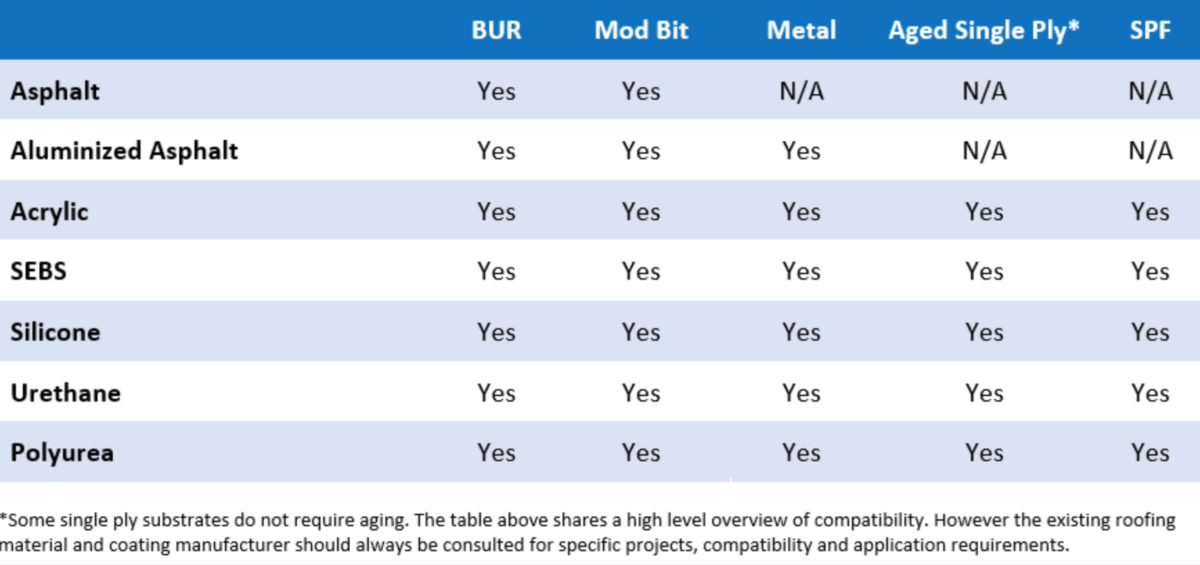
Understanding the Substrate
Before a coating can be applied to an existing roofing system, the surfaces must be cleaned carefully, and all leaks must be repaired. A roof coating is not intended to seal leaks. Some manufacturers (or roof coating technologies) will require a primer to facilitate adhesion over select substrates. When required, the primer is installed on the cleaned roof once the substrate is completely dry. Coatings should not be installed over wet or damaged roofing materials.
Asphaltic Substrates (BUR and Modified Bitumen)
Asphalt, aluminized asphalt and acrylic roof coatings are popular with asphaltic substrates. These substrates can be smooth surfaced (including a glaze or flood-coat of mopping asphalt), and in some cases can have a finish layer of gravel embedded in the hot asphalt. Alternatively, they may be covered with a mineral surfaced (granulated) cap sheet as a top protective layer. The following should be considered when choosing a roof coating.
• A mineral cap sheet receives a roof coating well. Its varied texture allows most roof coatings to achieve a strong mechanical bond. These minerals may also eliminate the need for a primer or base coat to block asphalt bleed.
• Smooth BUR systems are readily coated with solvent-borne asphalt coatings, but careful preparation and base coats are sometimes necessary before they can accept acrylic elastomeric coatings.
• Gravel-covered roofs are generally impractical to coat without removing the gravel. However, the removal of the gravel may affect a roof system’s fire rating. An approval of the existing roof system with the roof coating in lieu of the gravel may need to be provided to show compliance.
If the asphalt has not aged sufficiently, the asphalt may “bleed through” or “yellow” a white roof coating. Specially formulated primers or base coats help minimize this aesthetic concern.
Metal Substrates
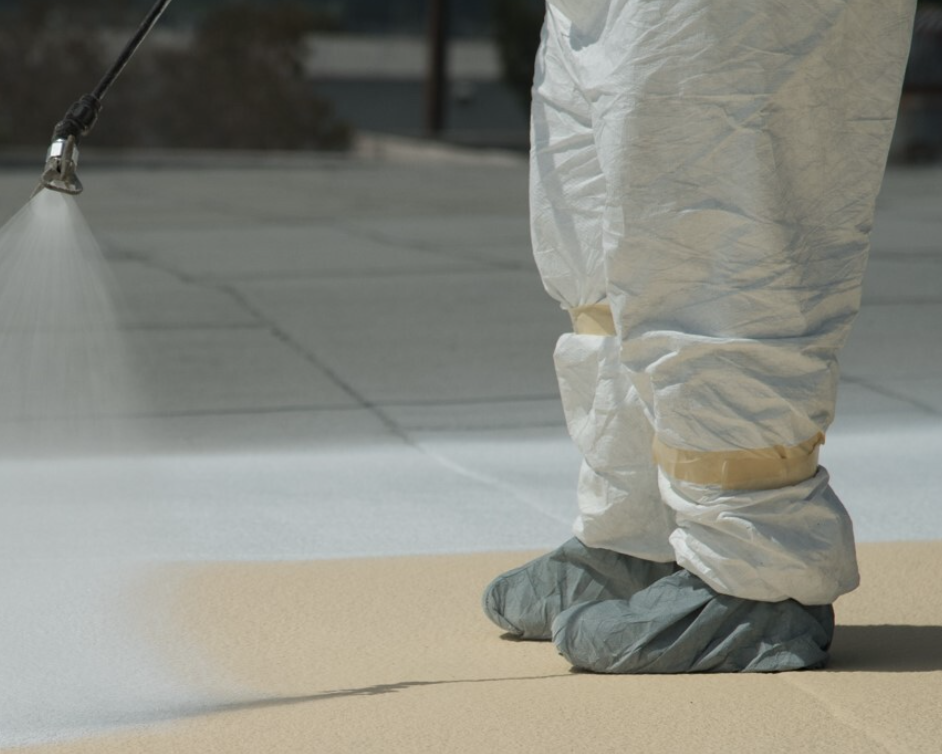
Today, metal roofing comes in a wide variety of colors, styles and finishes. Maintaining the visual appearance of an aging metal roof may be important to a building owner or property manager, but the most critical concern is keeping the roof leak free.
Whether refreshing a traditional galvanized metal panel with aluminized asphaltic coating or custom color matching with an acrylic elastomeric product, roof coatings and their associated sealants and mastics not only assure the watertight integrity of a metal roofing system, but also help maintain the value of the property by keeping the roof visually appealing.
In addition to ensuring a clean substrate, any areas rusted through should be removed and replaced with similar gauge metal. Surface rust areas should be wire brushed and may require encapsulation with a rust inhibitor to ensure proper adhesion. Seams and penetrations should be treated with compatible flashing or sealant products. Any metal panel should be tested to see if it has a specialty PVDF treatment (such as Kynar). The adhesion of coatings to these panels may require special preparation prior to the application of base and or finish coats.
Single-Ply Substrates
The application of a reflective coating not only preserves the performance of a sound roofing system but offers the unique advantage of reducing energy utilization and the heat island effect produced by large areas of darker colored or uncoated roofing materials.
Whether a roof is EPDM, Hypalon, PVC, or TPO, as with asphaltic systems, any needed repairs to stop leaks must be made first and the substrate must be clean and dry prior to the application of primers and roof coatings. Acrylic and silicone roof coatings are generally more popular with these substrates. As is the case with asphaltic substrates, special attention to the seams may be required. Many roof coating products offer greater viscosities specially designed for use with fabrics to provide enhanced protection at the substrate seams, penetrations and flashings.
Other Substrates
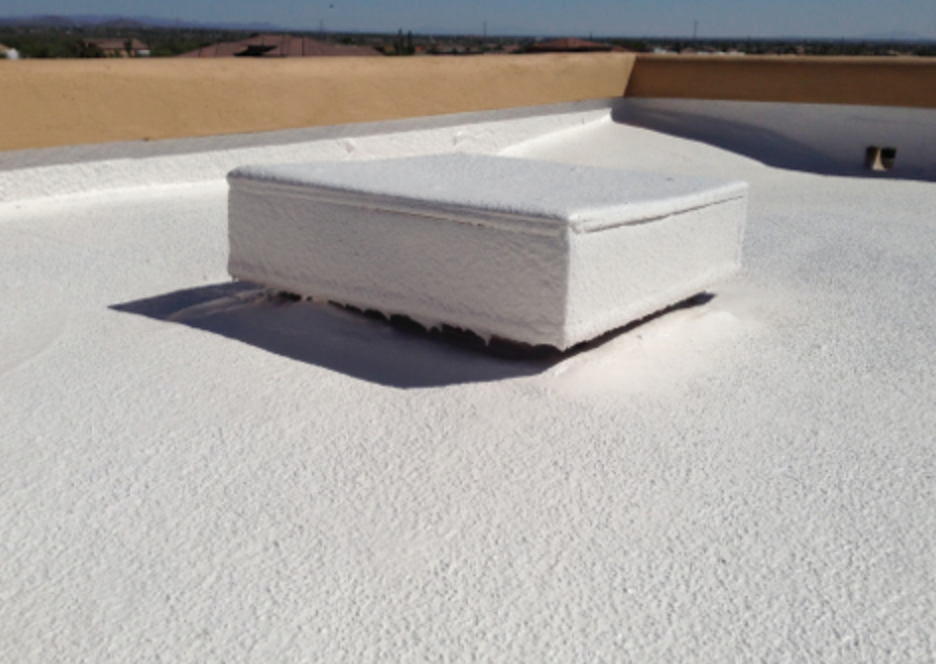
Due to the variety and versatility of coatings products available today, substrates such as wood, concrete, spray foam polyurethane, and corrugated transite panels may be suitable for roof coating products application directly or in conjunction with fabric. Roof coatings offer versatility and provide options that property owners and managers may not traditionally consider.
Other Key Elements to Consider
No matter the substrate or the roof coating product selected, there are a few best practices that apply to all projects.
• Confirm product compatibility.
• Perform adhesion testing to ensure adequate adhesion of coatings and sealants to the substrate.
• Examine the substrate and perform any needed repairs.
• Ensure the substrate is clean and dry to assure proper adhesion.
• Seal penetrations, fasteners, and/or seams as required. Compatible sealant products(with greater viscosities) are available from most coating manufacturers.
• Be mindful of temperature and impending rain, as these are of critical importance in the application of roof coating products.
• Follow proper material storage guidelines both on and off the roof to help maintain shelf life and assure the coating applies and performs as expected.
Temperature Considerations
Roof coatings are sensitive to temperature extremes. Viscosity, open time and cure time are impacted by cooler temperatures. Application/substrate temperatures that range over 110⁰ to 120⁰ Fahrenheit (43⁰ to 49⁰ Celsius) may also impact the success of the installation.
Application temperatures vary by technology. Acrylics and polyurethane generally require minimum applications temperatures of 40⁰ F (4⁰ C) and rising. Asphaltic, SEBS, and silicone roof coatings can typically be installed at temperatures between 40⁰ F and 100⁰ F (4⁰ C to 38⁰ C).
As part of proper storage and handling, materials should be kept from temperature extremes. Exposure to freezing or to temperatures above 100⁰ F (38⁰ C) may inhibit the product from performing as intended.
Full set times are dependent on many factors, including temperature, humidity, dew point, curing technology, solids content and coverage rates. Generally, colder temperatures, high humidity or high application rates slow the setup time. For the specific application temperatures and rates, storage conditions and mixing instructions, consult the individual manufacturer’s published literature.
Coating Technologies Overview
Asphalt & Aluminized Asphalt Roof Coatings
Solvent-borne asphaltic roof coatings are made from distillate bitumen residue (cutback) that is refined to various specific physical properties through vacuum distillation or oxidation. This refined asphalt then is blended with a petroleum solvent, such as PCBTF and others. The resin and solvent are combined with special clay fillers or fibers to create a gel coating.
Water-borne asphalt coatings are alternatives to solvent-borne roof coatings. The mixture of bitumen, water and bentonite (clay) is referred to as “asphalt emulsion” because the microscopic asphalt particles are held in suspension by a clay coating.
Solvent- and water-borne asphalt roof coatings can be formulated with aluminum pigment dispersed in them to protect against UV radiation and provide significant reflectivity. These roof coatings typically have solar reflectivity values between 0.40 and 0.50, although premium formulations have demonstrated initial solar reflectivity values greater than 70 percent. This application warrants a whole separate family of aluminized asphalt roof coatings.
Highly Reflective Coatings: Acrylic, SEBS, Silicone, Urethane and Polyurea
Highly reflective white topcoats can be used to minimize peak electrical demand for air conditioning in many buildings and reduce temperature cycles, which can stress and fatigue roof systems.
Like asphaltic coating products, these highly reflective roof coatings may be water based or solvent based. Since the range of physical and chemical properties available within the general category varies considerably, a particular coating’s suitability for a given substrate should be verified with the roof coating’s manufacturer.
Most white roof coatings have higher reflectivity values than aluminized coatings. Depending on the substrate, primers may be required. If installed over an aged white TPO or PVC substrate, a tinted base coat is often recommended to assure full coverage, and if installed over an asphaltic substrate, especially those repaired in preparation of the coating, a “bleed blocking” base coat is often recommended.
Innovation Driving Options
Roof coating manufacturers are engaged in continuous improvement efforts, driving innovation that improves performance, expands the application temperature range and overall versatility. As the industry drives to reduce the use of volatile organic compounds (VOCs), high-solids roof coatings are rising in popularity. These low-VOC roof coating products are also highly resistant to ponding water.
The wide variety of roof coatings expands the choices for property owners and managers offering affordable sustainable options. In these times, when budget considerations are at the forefront, the roof coatings industry has countless compatible solutions for almost any roof substrate. Be sure to check with your roof coating manufacturer to determine which roof coating is right for your application.
RCMA: The Authority on Roof Coatings
The Roof Coatings Manufacturers Association (RCMA) and its members have been refining their product offerings and improving guidance to contractors with respect to methods of application. RCMA provides the necessary training and guidance to accelerate the application of coatings, protecting roofing systems from extreme temperatures and conserving energy. For more information about types of roof coatings and general guidelines relating to their proper application, visit www.roofcoatings.org.
About the author: Chadwick Collins is the current Director of Technical Services for the Roof Coatings Manufacturers Association (RCMA), the national trade association representing manufacturers of asphaltic and solar reflective roof coatings and the suppliers to the roof coatings industry. He can be reached through the RCMA website, www.roofcoatings.org.

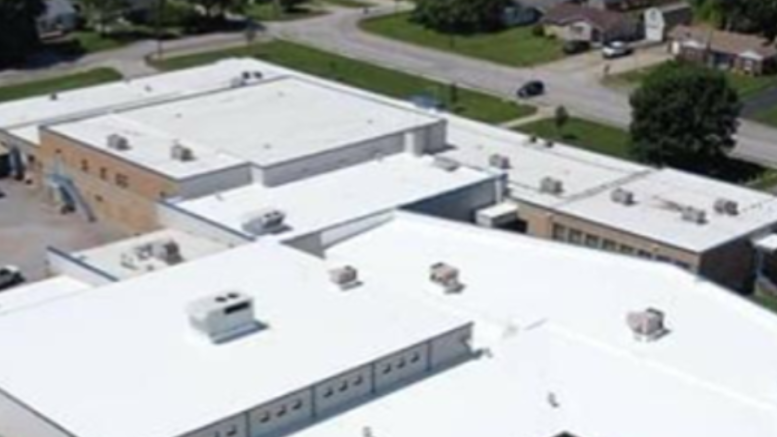

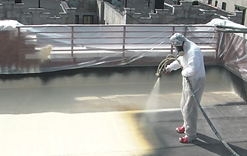
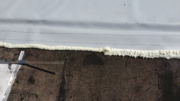
Be the first to comment on "Choosing and Applying the Right Coating for Any Application"